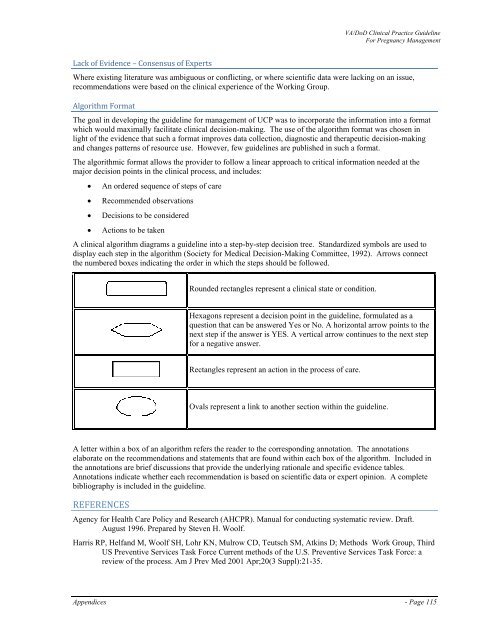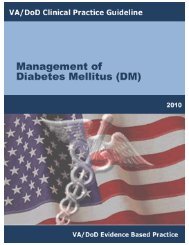Management of pregnancy - VA/DoD Clinical Practice Guidelines ...
Management of pregnancy - VA/DoD Clinical Practice Guidelines ...
Management of pregnancy - VA/DoD Clinical Practice Guidelines ...
Create successful ePaper yourself
Turn your PDF publications into a flip-book with our unique Google optimized e-Paper software.
<strong>VA</strong>/<strong>DoD</strong> <strong>Clinical</strong> <strong>Practice</strong> Guideline<br />
For Pregnancy <strong>Management</strong><br />
Lack <strong>of</strong> Evidence – Consensus <strong>of</strong> Experts<br />
Where existing literature was ambiguous or conflicting, or where scientific data were lacking on an issue,<br />
recommendations were based on the clinical experience <strong>of</strong> the Working Group.<br />
Algorithm Format<br />
The goal in developing the guideline for management <strong>of</strong> UCP was to incorporate the information into a format<br />
which would maximally facilitate clinical decision-making. The use <strong>of</strong> the algorithm format was chosen in<br />
light <strong>of</strong> the evidence that such a format improves data collection, diagnostic and therapeutic decision-making<br />
and changes patterns <strong>of</strong> resource use. However, few guidelines are published in such a format.<br />
The algorithmic format allows the provider to follow a linear approach to critical information needed at the<br />
major decision points in the clinical process, and includes:<br />
• An ordered sequence <strong>of</strong> steps <strong>of</strong> care<br />
• Recommended observations<br />
• Decisions to be considered<br />
• Actions to be taken<br />
A clinical algorithm diagrams a guideline into a step-by-step decision tree. Standardized symbols are used to<br />
display each step in the algorithm (Society for Medical Decision-Making Committee, 1992). Arrows connect<br />
the numbered boxes indicating the order in which the steps should be followed.<br />
Rounded rectangles represent a clinical state or condition.<br />
Hexagons represent a decision point in the guideline, formulated as a<br />
question that can be answered Yes or No. A horizontal arrow points to the<br />
next step if the answer is YES. A vertical arrow continues to the next step<br />
for a negative answer.<br />
Rectangles represent an action in the process <strong>of</strong> care.<br />
Ovals represent a link to another section within the guideline.<br />
A letter within a box <strong>of</strong> an algorithm refers the reader to the corresponding annotation. The annotations<br />
elaborate on the recommendations and statements that are found within each box <strong>of</strong> the algorithm. Included in<br />
the annotations are brief discussions that provide the underlying rationale and specific evidence tables.<br />
Annotations indicate whether each recommendation is based on scientific data or expert opinion. A complete<br />
bibliography is included in the guideline.<br />
REFERENCES<br />
Agency for Health Care Policy and Research (AHCPR). Manual for conducting systematic review. Draft.<br />
August 1996. Prepared by Steven H. Woolf.<br />
Harris RP, Helfand M, Woolf SH, Lohr KN, Mulrow CD, Teutsch SM, Atkins D; Methods Work Group, Third<br />
US Preventive Services Task Force Current methods <strong>of</strong> the U.S. Preventive Services Task Force: a<br />
review <strong>of</strong> the process. Am J Prev Med 2001 Apr;20(3 Suppl):21-35.<br />
Appendices - Page 115
















